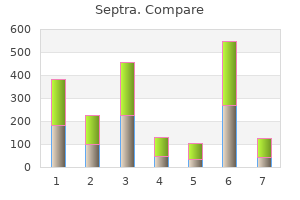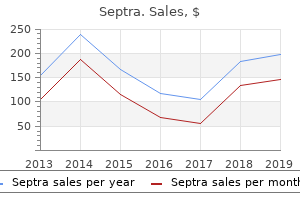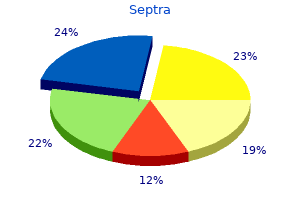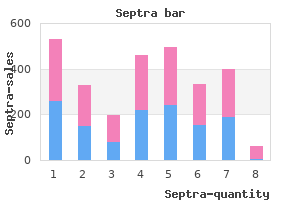"Generic septra 480mg with visa, medications 44 175".
By: G. Runak, M.B. B.CH. B.A.O., Ph.D.
Medical Instructor, Syracuse University
Treatment of ingrowing nail in children medicine 8162 cheap septra 480 mg with amex, acrylic affixed gutter splint treatment septra 480 mg mastercard, sculptured nail and taping medications like lyrica order septra 480 mg amex. Simple and effective non-invasive treatment methods for ingrown nail and pincer nail including acrylic affixed gutter splint medicine man septra 480 mg with visa, anchor taping, sculptured nails, shape memory alloy and plastic nail braces as well as 40% urea paste. Anchor taping method for the treatment of ingrown nail, nail trauma and other nail disorders. Surgical pearl: Nail splinting by flexible tube-A new noninvasive treatment for ingrown toenails. Sodium bicarbonate attenuates pain on skin infiltration with lidocaine, with or without epinephrine. Pain tolerance, especially during the local anesthesia, is the cornerstone of any surgical procedure. Fortunately, the indications of a nail biopsy in a child are very limited and should be done only for specific purposes. Indications of Nail Biopsy in Children Contrary to adults, nail biopsy is rarely performed in children, unless necessary. Indeed, the scope of nail conditions in children is different from the one in adults and hopefully, many pediatric nail diseases are clinically recognizable. The latter is aggressive and should be diagnosed as soon as possible to avoid any permanent scarring. Nail psoriasis is much less often biopsied as there are in most cases clues to help the diagnosis, such as plaques on the body or scalp or a familial history of psoriasis. Moreover, there are no dystrophic sequelae from the disease and the treatment mostly remains topical. The lesion is biopsied because it has an unusual location or an unusual presentation5 (Figure 19. In some rare instances of dominant dystrophic epidermolysis bullosa, the nail abnormalities may be the only sign of the condition over several generations. One should remember that the stress of the parents is very easily transmitted to the child. Older children should be included in the discussion and a simple, clear, and reassuring explanation should be given to them. There are no specific studies on nail surgery procedures in children, but one may get good information from publications on venous puncture and dental procedures in this age group. Several studies compared different regimens: those with midazolam, chloral hydrate, hydroxyzine, and mepiridine, respectively. It is amazing to discover how parents are unable to carry out this kind of dressing. A demonstration on how to perform an adequate occlusion (with any cream) during the preoperative consultation is of great help. Time of occlusion should be respected, too, at least 2 hours prior to the procedure for fingers or toes. It is a cost-effective and efficacious alternative to conscious sedation or general anesthesia for minor pediatric surgical procedures. Managing the Child during the Biopsy Pain from the Needle As previously mentioned, children mostly fear the needle. However, it is sometimes impossible to apply before the procedure (parents forgot, waited too long, did not do it properly) and other tips should be used to overcome the discomfort from the needle insertion. Pain is highly subjective, and it is neurologically proven that stimulation of large diameter fibers using cold, rubbing, pressure, or vibration can close the neural "gate" so that the central perception of pain is reduced. The mother (or the nurse) may be asked to firmly press on the point of injection for at least 5 minutes before the needle prick. Another option is to use a vibrating tool for several minutes, at the location of the future injection, until the child finds that the area is becoming numb (Figure 19. This was demonstrated as an effective method to decrease pain during local anesthesia. Downloaded by [Chulalongkorn University (Faculty of Engineering)] at Pain from Dilation Once the needle is inserted painlessly, the infusion of the anesthetic may start. The subungual space is very limited, and excessive pressure on the Vater-Pacini corpuscules within the distal soft tissue will trigger pain. The injection should be extremely slow, thus performing a very slowly progressive swelling. It is not unusual to spend more time performing the anesthesia than the surgical procedure itself.

At present there is no absolute weight or percentage of body fat that indicates when a patient is actually ready to begin formal psychotherapy symptoms of pneumonia purchase 480mg septra with mastercard. In addition treatment vaginitis purchase 480 mg septra with amex, patients often display improved mood medications in carry on purchase septra in india, enhanced cognitive functioning symptoms blood clot leg buy cheap septra, and clearer thought processes once their nutritional status has significantly improved and even before they make substantial weight gains. Little evidence from controlled studies exists to guide clinicians in the use of specific therapies for adults with anorexia nervosa. Many clinicians also use psychodynamically oriented individual or group psychotherapy to address underlying personality disorders that may hamper treatment and help sustain the illness and to foster psychological insight and maturation in patients who have made strides toward weight restoration (141148). Although studies of psychotherapies focus on different interventions as distinctly separate treatments, in practice there is frequent overlap among treatments. Indeed, most experienced clinicians report using interventions that cross theoretical boundaries when treating patients with eating disorders (153). In adolescents, controlled studies have shown that for patients who are younger than age 19 years, have been ill for 3 years or less, and have restored their weight, family therapy is more beneficial than individual therapy, whereas individual therapy is more beneficial for patients with later-onset disorders (154). At 5-year follow-up of patients who received these therapies, much of the improvement could be attributed to the natural outcome of the illness, but it was still possible to detect long-term benefits of the psychological therapies (155). Countertransference feelings often include beleaguerment, demoralization, and excessive need to change patients with a chronic eating disorder. At the same time, when treating patients with chronic illnesses, clinicians need to understand the longitudinal course of the disorder and that patients can recover even after many years of symptoms. Such awareness may help clinicians maintain a degree of therapeutic optimism and deal with the feelings of pessimistic demoralization that may arise (13, 163). Some observations suggest that the gender of the clinician may play a role in the particular kind of countertransference reactions that come into play (156, 157). In addition, cultural differences between patients and clinicians or patients and other aspects of the care system may also influence the course and conduct of treatment and require attention. When a patient with an eating disorder has been sexually abused or has felt helpless in other situations of boundary violations, this may stir up needs in the clinician to rescue the patient, which can occasionally result in a loosening of the therapeutic structure, the loss of therapeutic boundary keeping, and a sexualized countertransference reaction. In some cases, these countertransference responses have led to overt sexual acting out and unethical treatment on the part of the clinician that have not only compromised treatment but also severely harmed the patient (166). The maintenance of clear boundaries is critical in treating all patients with eating disorders, not only those who have been sexually abused but also those who may have experienced other types of boundary intrusions regarding their bodies, eating behaviors, and other aspects of the self by family members or others. Regular meetings with other team members and/or formal supervision can also help clinicians avoid boundary violations with eating disorder patients. However, the license to be informal may create a climate in which a clinician is at a greater risk to violate therapeutic boundaries; such an occurrence must be consistently and carefully prevented. Some clinicians use group psychotherapy as an adjunctive treatment for anorexia nervosa; in such cases, however, caution must be taken that patients do not compete to be the thinnest or sickest patient in the group or become excessively demoralized by observing the ongoing struggles of other patients in the group. For that reason, clinicians sometimes prefer heterogeneous groups that combine patients with bulimia nervosa and those with anorexia nervosa. Some clinicians consider that eating disorders may be usefully treated through addiction models, but no data from short- or long-term outcome studies using these methods have been reported. Literature from Anorexics and Bulimics Anonymous and Overeaters Anonymous emphasizes that these programs are not substitutes for professional treatment. These organizations specifically recommend that members seek appropriate medical and nutritional guidance. Nevertheless, there are concerns about zealous and narrow application of the 12-step philosophy in addiction-oriented programs for eating disorders. Programs that focus exclusively on abstaining from binge eating, purging, restrictive eating, and exercise. Clinicians frequently report encountering patients who, while attempting to resolve anorexia nervosa by means of a 12-step program alone, might have been greatly helped by concurrent conventional treatment approaches such as nutritional counseling and rehabilitation, medications, and psychodynamic or cognitive-behavioral approaches. By limiting their attempts to recover to their participation in a 12-step program alone, patients not only deprive themselves of the potential benefits of conventional treatments but also may expose themselves to misinformation about nutrition and eating disorders offered by well-intended nonprofessionals participating in and sometimes running these groups. Attempts have been made to integrate traditional and 12-step approaches into treatment; such approaches can offer a strong sense of community, but the effectiveness and potential adverse effects of these combined interventions have not been systematically studied (167). It is important for programs using a 12-step model to be equipped to care for patients with the substantial psychiatric and general medical problems often associated with eating disorders. Selective support groups led by professionals and advocacy organizations may be beneficial as adjuncts to other psychosocial treatment modalities. Sometimes, participants Treatment of Patients With Eating Disorders 47 Copyright 2010, American Psychiatric Association. Patients and their families are increasingly using online web sites, news groups, and chat rooms as resources.

The patient had a routine postoperative course and was discharged on postoperative day 1 symptoms mononucleosis buy generic septra 480 mg on-line. Conclusion: Patients presenting with intra-abdominal pathology and situs inversus can present a challenge in diagnosis 6 mp treatment buy cheap septra 480 mg on-line. Specifically treatment breast cancer buy septra 480 mg otc, patients with left-sided appendicitis can present with left lower quadrant pain that can be interpreted as a different process symptoms 5dpo order septra master card, such as diverticulitis. Laparoscopy can also be useful in defining the anatomy in these difficult situations. Purpose: the purpose of this study is to assess the impact routine blood cultures have on the management / outcome of patients admitted with the working diagnosis of acute diverticulitis. Methods: Retrospective chart review of all patients admitted to the Western Pennsylvania Hospital Main and Forbes Regional campuses from June 1, 2004 to June 30, 2007 with the diagnosis of acute diverticulitis and whom had blood cultures performed upon admission. Results: the charts of 30 patients admitted with the diagnosis of acute diverticulitis in whom blood cultures were obtained were reviewed. There were no changes in antibiotic regimens until the patients were able to tolerate oral intake and prepared for discharge. Conclusion: There is no evidence to support the notion that blood cultures alter the decision making or care of patients with acute diverticulitis. Based upon the results of this study it is suggested that blood cultures no longer be obtained as routine admission orders for patients with acute diverticulitis. Methods: the base cohort was patients presenting with post-operative esophageal leaks. Success was defined as no major procedure-related and long-term complications over a 1-month period. Failure of therapy was defined as recurrent symptoms or death due to a procedural complication. Sensitivity analyses and cost-effectiveness analyses for the various strategies were performed. Although useful, this assessment becomes problematic when employing cost-effectiveness studies where utilities, a scale from 0 (death) to 1 (full health), is the preferred denominator. The Nichol, Fryback and Brazier translation methods yielded 3 estimated utilities at baseline and after treatment in both the home and office biofeedback groups. Results: 51 patients (25 office and 26 home) completed biofeedback therapy; Median age 35. After adjusting for type of biofeedback therapy and treatment phase, only translation method remains statistically different (p<. Conclusion: the choice of translation method can affect estimated utilities and consequently may influence the interpretation of a cost-effectiveness study. These factors should be considered when analyzing data for cost effectiveness studies. The methodological quality of trials was evaluated using the score devised by Jadad et al (ranging from 1=low to 5=high). We also assessed nighttime criteria used for patient enrollment, nighttime outcomes measured, and the nighttime definition used. Methodological quality of trials was high with 28 of the 32 trials attaining a Jadad score of at least 3 points. The majority of studies assessed nighttime symptoms as a secondary outcome; erosive esophageal healing was usually the primary endpoint. Thirty studies (94%) assessed nighttime heartburn; few studies evaluated overall nighttime symptoms (n=4) and only one study evaluated regurgitation as an independent outcome. Nighttime heartburn outcomes measured were percentage of patients without nighttime heartburn (n=18), percentage of heartburn-free nights (n=15), heartburn severity score (n=11) or time to heartburn relief (n=6). The time window for the assessment of nighttime symptoms was reported in only 3 studies (9%) and was not based on specific hours but on sleep or posture (retiring or lying down to sleep). Aguilar are employees of Cerner LifeSciences, a provider of research and consulting services to pharmaceutical companies, including Wyeth. The metabolic syndrome increases the risk of colorectal cancer but this association with colorectal adenomas has not been extensively reported.

This means that several sources were used to estimate a more accurate figure symptoms acid reflux order line septra, but there is room for error in either direction treatment of shingles proven 480mg septra. The study goes on to say that many Aboriginal service providers believe this figure to be a conservative one symptoms high blood pressure buy 480mg septra visa. The report cites Aboriginal leaders and service providers estimating the Aboriginal population to be "up to 60 medications known to cause nightmares buy septra 480mg with amex,000 Aboriginal people live in the lower mainland or Greater Vancouver area. Likewise, the number of street-involved persons both fluctuates and is difficult to measure because street-involved people are often moving targets or migratory. The program cited two startling figures in its year-end report: "40% of the street youth population in Vancouver has self-identified themselves as gay, lesbian, bisexual, transgendered or questioning youth. Four questions were asked seeking individual views on homosexuality and also what they felt were the views of their family and community. Each of the four response areas showed that approximately 80 per cent of the responses held negative views toward homosexuality. Many people who identify as two-spirited, gay, lesbian, or bisexual migrate to larger cities where there is greater anonymity as well as a gay community. This does not imply that homophobia or other negative feelings and attitudes toward gay/lesbian people do not exist in a city. In fact, gay bashing does occur and street-involved people, gay/lesbian or not, also find themselves as victims of assault. These key aspects will Kevin Barlow be explored throughout this study as it relates to the needs and services provided through the gay/lesbian youth program. There is a logical link between the day-to-day activities a project undertakes, what they hope to achieve in the short term, and the desired long-term outcome. In this case, the program wanted to provide support through individual and group counselling to gay/ lesbian youth, which included creating awareness of and healing from the intergenerational effects of residential schools. Education on both residential school and gay/lesbian issues was delivered to social service providers, schools, universities, and other community agencies. The relationship between project activities and short- and long-term outcomes is set out in the logic model (Figure 1). The following performance map (Figure 2) provides a summary of project activities, outputs, outcomes, and information required to measure progress over the short and long term. Case Study Report: Two-Spirited Youth Program Figure 1) Logic Model-Two-Spirited Youth Program Regular group meetings for gay/ lesbian Aboriginal youth. Establish contact with youth agencies (mainstream, Aboriginal, and gayspecific); distribute information about program; and direct street outreach. Increased awareness of programs for and among Aboriginal gay/lesbian youth and among front-line workers, agencies, and community at large. Increased demand for services, including increase in # of referrals from outside agencies. Workshops and public education aimed at increasing understanding about gay/lesbian youth and residential school legacy. Activity How we did it Individual counselling aimed at healing present-day crises and intergenerational impacts of residential school abuse. What we wanted Peer support to enhance healing around issues of sexual abuse, low selfesteem, depression, and homophobia. Level of participation in groups sustained and increased over time; observed and self-reported increases in peer support, healing, and healthy lifestyles; and reduced rates of substance abuse, depression, and suicide. Healing around issues of sexual abuse, low self-esteem, depression, coping with sexuality, and homophobia in schools. Increased awareness among front-line workers, agencies, community, and gay/lesbian youth on residential schools and gay/lesbian issues. Evidence that media and key informants in other agencies have an understanding of the intergenerational impacts of residential schools and of gay/lesbian issues; and evidence that Legacy is acknowledged and discussed in counselling and group work. How we know things changed (short term) Self-reported and observed increases in coping with sexuality, homophobia, and depression; increased level of self-esteem; decreased rates of suicide (and attempts), sexual abuse, and substance abuse; and decrease in # of gay/lesbian youth on the streets. Why we are doing this How we know things changed (long term) Gay/lesbian youth are off the streets and engaged in healthier lifestyles, free of abuse, depression, and suicide. Reduced rates of suicide, attempted suicide, and gay/lesbian youth living on the streets and engaged in abusive behaviours (alcohol and drug abuse, sexual exploitation). Resources activities/outputs Provide peer support/healing through regular group meetings and individual counselling; establish contact with youth agencies and other social service providers, the media, youth on the streets, and the community at large regarding issues of residential school abuse, intergenerational impacts, and gay/lesbian youth (including the availability of programs to serve them).
Generic septra 480 mg without a prescription. Epstein Barr Virus and Infectious Mononucleosis (pathophysiology investigations and treatment).

We review five cases of duodenal carcinoid tumors diagnosed at our institution from 2004-2008 symptoms bladder cancer buy genuine septra. Results: Of the five cases symptoms zoning out buy cheap septra 480 mg on-line, there were four men and one woman medicine 74 cheap septra 480mg visa, with ages ranging from 50 to 73 symptoms mononucleosis order septra 480mg. Three patients were asymptomatic and discovered incidentally, and two presented with painless jaundice. Two carcinoid tumors were located in the duodenal bulb, two in the periampullary area, and one in the second portion of the duodenum. The two periampullary carcinoid cases presented with symptoms of obstructive jaundice, and the others were asymptomatic. One of them presented with painless jaundice and was found to have a periampullary carcinoid and positive lymph nodes. The second patient had carcinoid in the second portion of the duodenum and liver metastases, but was asymptomatic. Of the two patients with large periampullary tumors, one patient without any metastases had a curative pylorus-sparing pancreatoduodenectomy. The patient who had a pylorus-preserving Whipple was asymptomatic after 12 months. The patient who had a periampullary carcinoid with metastases to lymph nodes but no surgical treatment has been doing well on treatment with octreotide alone after 28 months. This clinical course is reflective of the usually indolent course of carcinoid tumors. Conclusion: Duodenal carcinoid tumors are rare, and can be discovered incidentally or with symptoms, such as obstructive jaundice, when the ampulla is involved. The course is typically indolent, and the presence of metastases and co-morbidities can determine appropriate intervention. Purpose: Introduction: Sickle cell hepatopathy is used as a general term to describe liver dysfunction occurring in the sickle cell patient. Ten days prior to transfer, she was admitted to an outside hospital in sickle cell crisis. While undergoing treatment for her sickle crisis, she developed worsening liver dysfunction and a severe coagulopathy, associated with hepatic encephalopathy. She was transferred for further evaluation and to be considered for possible liver transplantation. On admission to our facility the patient was somnolent with marked asterixis (Stage 3 hepatic encephalopathy). Abdominal ultrasound with Duplex Doppler revealed hepatomegaly, no ascites, normal flow in the portal and hepatic veins. Conclusion: Discussion: Our patient presented with fulminant hepatic failure associated with severe sickle cell intrahepatic cholestasis. While concomitant cocaine ingestion may have contributed to the severity of her liver injury, the pattern of injury and clinical course were not consistent with cocaine hepatoxicity. Her dramatic response to exchange transfusion reinforces the success of this treatment in patients with intrahepatic cholestatic sickle cell hepatopathy, including those presenting with fulminant hepatic failure. These patients can be treated in a general medical facility capable of performing exchange transfusions, and are rarely, if ever, liver transplant candidates. Thus, initiation of exchange transfusion should not be delayed while attempting to transfer these patients to liver transplant centers. Laboratory Data follow, as 80% of patients will demonstrate spontaneous resolution. In contrast, some groups have successfully punctured hematomas for immediate drainage. Conservative treatment frequently results in recurrent bleeding only controlled by surgery. Infliximab rapidly induces mucosal healing and can prevent further hemorrhage without need for surgery. Her remission was induced by prednisone and mesalamine and she otherwise felt well.


